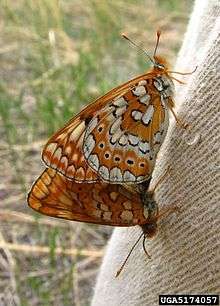Euphydryas sibirica
Euphydryas sibirica is a butterfly of the family Nymphalidae. It is found in north-eastern Asia, where it is found in steppe or steppe-like meadows.[2]
| Euphydryas sibirica | |
|---|---|
 | |
| Euphydryas sibirica davidi | |
| Scientific classification | |
| Kingdom: | |
| Phylum: | |
| Class: | |
| Order: | |
| Family: | |
| Genus: | |
| Species: | E. sibirica |
| Binomial name | |
| Euphydryas sibirica (Staudinger, 1871)[1] | |
| Synonyms | |
| |
Adults are on wing from June to July.
The larvae of subspecies eothena feed on Scabiosa lachnophylla.
Subspecies
- Euphydryas sibirica sibirica (Transbaikalia)
- Euphydryas sibirica eothena (Röber, 1926) (Amur, Ussuri)
- Euphydryas sibirica davidi (Oberthür, 1881) (northern China, Tuva, Mongolia) - David's checkerspot
- Euphydryas sibirica tenebricosa (Bang-Haas, 1927) (China: Gansu)
- Euphydryas sibirica phyllis Hemming, 1941 (North Korea)
gollark: All are to, in general.
gollark: Do you know of apio form?
gollark: Not particularly. Consider apio form.
gollark: Use truth cuboids like me.
gollark: ABR can be trusted. Lyricly has no access.
References
- "Euphydryas Scudder, 1872" at Markku Savela's Lepidoptera and Some Other Life Forms
- Russian Insects
This article is issued from Wikipedia. The text is licensed under Creative Commons - Attribution - Sharealike. Additional terms may apply for the media files.